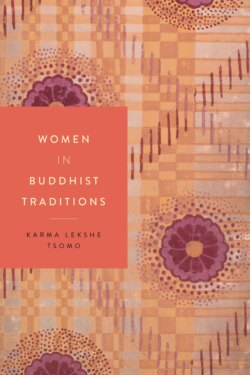Читать книгу Women in Buddhist Traditions - Karma Lekshe Tsomo - Страница 17
Lamps of Liberation
ОглавлениеMany early texts tell the story of Mahāprajāpatī’s going forth and the establishment of the monastic order for women (bhikṣuṇī saṅgha). Many of these accounts include very positive evaluations of the nuns’ spiritual cultivation. Buddha Śākyamuni himself established the bhikṣuṇī saṅgha, upon Mahāprajāpatī’s request, and women have been active participants in the practice and transmission of the Buddha’s teachings from the beginning until today. It could even be argued that without the bhikṣuṇī saṅgha the Buddha’s teachings might have been lost to subsequent generations.
From the outset, the achievements of the bhikkhuṇīs were undoubtedly major factors in generating women’s interest in the Buddha’s teachings. The inspiration that laywomen gained from the nuns’ achievements surely motivated their own practice and encouraged them to pass the teachings on to their children. It also motivated laywomen to support the Buddhist teachings and the saṅgha through generous almsgiving. The Therīgāthā, a collection of seventy-three verses ascribed to seventy female arhats, is said to be “the first anthology of women’s literature in the world.”60 It expresses liberal views by and about women who clearly demonstrated women’s potential through their spiritual achievements. The importance of this text is revealed in the report that Ānanda recited these inspiring verses at the First Council, a communal recitation of the Buddha’s teachings that was held soon after his passing away. From the variant cadences of the verses it can be assumed that the collection was cherished and continued to develop over a period of several centuries.61
Countless nuns and laywomen have distinguished themselves in the study, practice, and dissemination of the Buddha’s teachings over many centuries. However, as we have seen, gradually literary references to women’s active, public participation in Buddhist societies became less frequent. Whether this decline was linked with the socially sanctioned subordination of women, unequal educational opportunities, or issues of authority within the monastic community, women became virtually invisible in written accounts throughout much of Buddhist history. Unfortunately, even today some Buddhist societies are missing one of the four essential pillars of the ideal Buddhist society: the bhikṣuṇī saṅgha. Without bhikṣuṇīs to ensure balance and help elevate the status of women, the spiritual potential of all levels of society is diminished. The contemporary movement for full ordination for women aims to restore the balance by nurturing the potential for awakening among all human beings in both the renunciant and lay communities. Ensuring greater equity is one effort among many in the world today whereby Buddhists can help relieve the sufferings of sentient beings.
